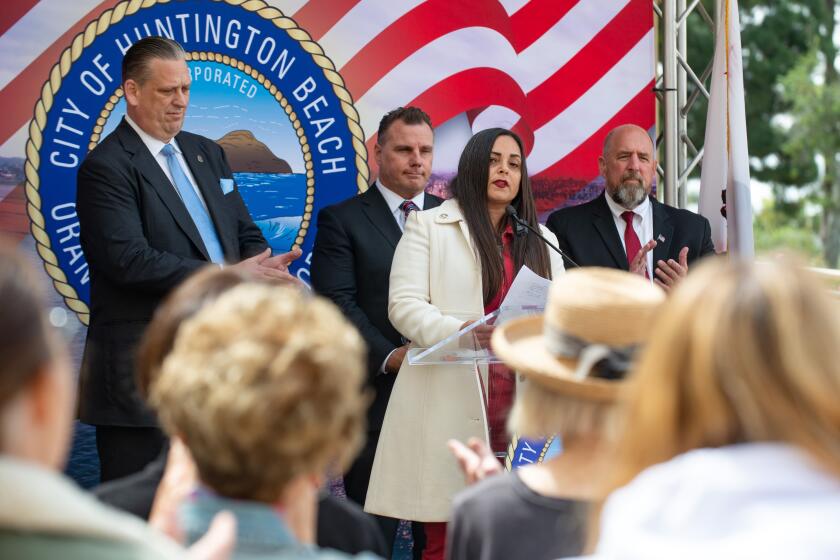Hansen: Humanitarian artists give back
It’s no secret that many artists suffer.
Chances are high that they struggle with some form of mental illness. They may have overcome addiction, abuse or neglect, according to several studies.
Despite it all, they persevere through their work. There simply is no other way.
So it probably should come as no surprise that artists at the Laguna Gallery of Contemporary Art are giving back to the issues and programs that are important to them.
After transferring ownership about six months ago to Michael Roy, the gallery at 611 South Coast Hwy. now exclusively features humanitarian artists.
From autism to sex trafficking prevention, the proceeds benefit charitable groups from around the world.
Spearheaded by art director, artist and Laguna Beach resident Christiana Lewis, the gallery’s mission is an outgrowth of Lewis’ own beliefs and practices. A devout Christian, Lewis has been donating her time and money to support and teach children in small villages in India, Laos, Mexico and low-income cities in the U.S.
“Traveling around the world almost my entire life, I’ve studied Buddhism and Hinduism and Judaism and pretty much almost every religion there is and found that love is the key,” Lewis said. “I think God gives us all a gift. I do know that a lot of artists are very emotional. I think if you’re a truly deep-feeling emotional artist, then you’re probably going to have a pretty strong spiritual side as well.”
Lewis started her introspection early in life. Orphaned at a young age, she remembers the feelings of uncertainty and loss. Her paintings now reflect these emotions with a fluid abstraction and desire for connection.
“We paint about our lives. So I paint about what I’ve gone through,” she said. “I’ve gone through so much in my life. Being adopted and orphaned at 4, that’s pretty traumatic. I’ve been through hell and back.
“I never wanted children to feel the way I did. I always wanted to make these kids feel love and feel good.”
Two years ago, Lewis went to India for three months, rented a small studio and simply opened her doors to the village children. At first, only a few came, then more and soon she was teaching about 30 children how to paint — every day.
“I was teaching some kids who had no idea they had talents. They were so shy and insecure. And after staying there for three months, they turned out to be the most talented artists.”
Lewis hopes that the impact to the children is not short-lived. She remembers that in her own life, three months could feel like a lifetime.
“I do remember some of the impacts that my foster parents had. I never look back and say, ‘Oh wow, I was abandoned and neglected by them. How come they didn’t keep me?’ I think to myself, I was so lucky that they kept me for the time they did, and I got so much love in that moment. And that gave me hope for who I am now.”
*
Widespread philanthropy
The other humanitarian artists at the gallery have their own stories of passion and empathy.
Steve Klinsky grew up a preacher’s kid and the lessons stuck with him.
“In buying groceries for food kitchens, gifting money to inner-city church benevolence funds, supporting environmental conservation efforts, AIDS and cancer charities, I learned that there is always a need for help somewhere,” he said.
Max Carraher said for the past year he has donated half of his income to five groups: Applied Scholastics, which fights illiteracy; Narconon, a drug rehabilitation program; Citizens Commission on Human Rights; Criminon International, which sets up criminal reform programs in prisons across the world; and Volunteer Ministers, a volunteer disaster relief group.
Dana McMullen supports suicide prevention and mental health issues.
Joseph Moscoso gives to an orphanage in Tijuana, Mexico.
Dorit Moss teaches art to autistic children.
The list goes on and on.
“I’m not trying to save the world,” Lewis said. “I just want to make people feel better, honestly — show people you can go from the dark to the light. People can see a lightness somewhere, so they can feel they won’t be depressed forever or have an eating disorder forever or feel unloved forever. That you can come, no matter what your thing is, to the other side.”
Art is a universal language that can start conversations, create excitement where none existed and if needed, begin some kind of healing.
Who better to show that path forward than the artists themselves.
DAVID HANSEN is a writer and Laguna Beach resident. He can be reached at davidhansen@yahoo.com.
All the latest on Orange County from Orange County.
Get our free TimesOC newsletter.
You may occasionally receive promotional content from the Daily Pilot.



